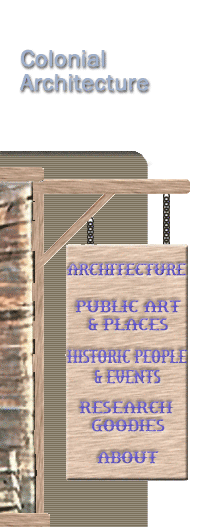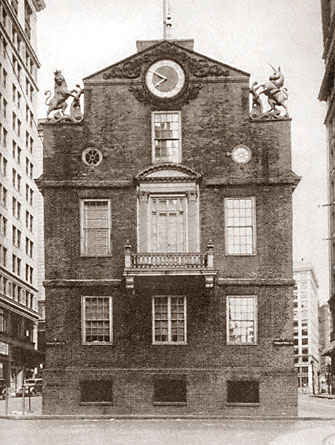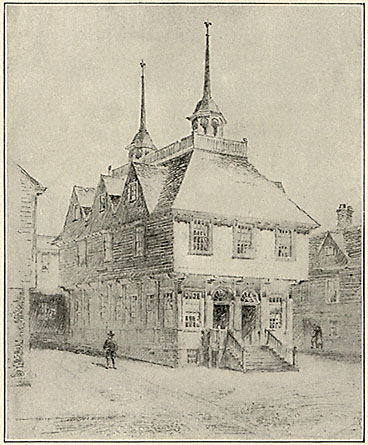
| 
Old State House
Robert Twelves (attributed)
1657/1711/1747

It was called the Town House, the court of the provisional governor, City
Hall, and in time became the statehouse of the Commonwealth of Massachusetts.
This was the site of Puritan stockades and Boston's first trading floor.
The Boston Massacre
took place here, and the Declaration of Independence was first read from
its balcony.
The
brilliant red brick building is highly symmetrical and ornamented. Its gambrel
roof is obscured by pedimented end facades. Its primary feature is a tall
multi-part steeple with elaborate clear glass windows. Also prominent are
the lion and unicorn statues (symbols of royal authority) positioned on
the gables. These figures were torn down during the celebration of America's
independence, and restored in 1882. Beneath the figures are bull's-eye windows,
and a ceremonial balcony. The balcony is further ornamented with a segmented
pediment over Corinthian pilasters. The building's High Georgian style and
formal ornamentation suggests that the 1747 State House was designed by
a trained British architect, and not an American.
 The
original Boston Town House was the bequest of Robert Keayne in 1657. The
bottom of the medieval looking wooden structure was a trading market and
gathering place for conducting business. Town and provincial offices were
upstairs, as was a meeting hall. Like London, Boston was oriented around
the sea. Naturally the Town House overlooked the Town Port. As Boston filled-in
its shoreline, this site became ever more inland. Located on the intersection
of the old King and Cornwall streets, the Town House was the center of civic
life. Though lost in the great fire of 1711, it was rebuilt by the various
government bodies for civic and business use. The
original Boston Town House was the bequest of Robert Keayne in 1657. The
bottom of the medieval looking wooden structure was a trading market and
gathering place for conducting business. Town and provincial offices were
upstairs, as was a meeting hall. Like London, Boston was oriented around
the sea. Naturally the Town House overlooked the Town Port. As Boston filled-in
its shoreline, this site became ever more inland. Located on the intersection
of the old King and Cornwall streets, the Town House was the center of civic
life. Though lost in the great fire of 1711, it was rebuilt by the various
government bodies for civic and business use.
Today the Old State House has been put to adaptive use. Besides being used
for a museum and historic study, it also provides an entrance to the State
Street subway stop. The Old State House's shallow foundation provided an
area for the subway stops to be stacked beneath it, without having to dig
beneath the far deeper foundations of the surrounding buildings.
|
|
| INTRODUCING |
|
From the writers of iBoston.org |
|
|
|



